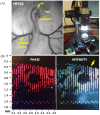Soft-Tissue Material Properties and Mechanogenetics during Cardiovascular Development
- PMID: 35200717
- PMCID: PMC8876703
- DOI: 10.3390/jcdd9020064
Soft-Tissue Material Properties and Mechanogenetics during Cardiovascular Development
Abstract
During embryonic development, changes in the cardiovascular microstructure and material properties are essential for an integrated biomechanical understanding. This knowledge also enables realistic predictive computational tools, specifically targeting the formation of congenital heart defects. Material characterization of cardiovascular embryonic tissue at consequent embryonic stages is critical to understand growth, remodeling, and hemodynamic functions. Two biomechanical loading modes, which are wall shear stress and blood pressure, are associated with distinct molecular pathways and govern vascular morphology through microstructural remodeling. Dynamic embryonic tissues have complex signaling networks integrated with mechanical factors such as stress, strain, and stiffness. While the multiscale interplay between the mechanical loading modes and microstructural changes has been studied in animal models, mechanical characterization of early embryonic cardiovascular tissue is challenging due to the miniature sample sizes and active/passive vascular components. Accordingly, this comparative review focuses on the embryonic material characterization of developing cardiovascular systems and attempts to classify it for different species and embryonic timepoints. Key cardiovascular components including the great vessels, ventricles, heart valves, and the umbilical cord arteries are covered. A state-of-the-art review of experimental techniques for embryonic material characterization is provided along with the two novel methods developed to measure the residual and von Mises stress distributions in avian embryonic vessels noninvasively, for the first time in the literature. As attempted in this review, the compilation of embryonic mechanical properties will also contribute to our understanding of the mature cardiovascular system and possibly lead to new microstructural and genetic interventions to correct abnormal development.
Keywords: arterial pressure; cardiac output; cardiovascular development; cardiovascular microstructure; cardiovascular system; chick embryo; congenital heart defects; embryonic development; embryonic heart; heart-valve development; hemodynamics; optical coherence tomography; residual stresses; soft-tissue mechanics; strain energy.
Conflict of interest statement
The authors declare no conflict of interest.
Figures




Similar articles
-
Microstructure of early embryonic aortic arch and its reversibility following mechanically altered hemodynamic load release.Am J Physiol Heart Circ Physiol. 2020 May 1;318(5):H1208-H1218. doi: 10.1152/ajpheart.00495.2019. Epub 2020 Apr 3. Am J Physiol Heart Circ Physiol. 2020. PMID: 32243769
-
Biomechanical properties and microstructure of human ventricular myocardium.Acta Biomater. 2015 Sep;24:172-92. doi: 10.1016/j.actbio.2015.06.031. Epub 2015 Jun 30. Acta Biomater. 2015. PMID: 26141152
-
Spatiotemporal remodeling of embryonic aortic arch: stress distribution, microstructure, and vascular growth in silico.Biomech Model Mechanobiol. 2020 Oct;19(5):1897-1915. doi: 10.1007/s10237-020-01315-6. Epub 2020 Mar 4. Biomech Model Mechanobiol. 2020. PMID: 32130562
-
Role of the vascular endothelial growth factor isoforms in retinal angiogenesis and DiGeorge syndrome.Verh K Acad Geneeskd Belg. 2005;67(4):229-76. Verh K Acad Geneeskd Belg. 2005. PMID: 16334858 Review.
-
Congenital heart malformations induced by hemodynamic altering surgical interventions.Front Physiol. 2014 Aug 1;5:287. doi: 10.3389/fphys.2014.00287. eCollection 2014. Front Physiol. 2014. PMID: 25136319 Free PMC article. Review.
Cited by
-
OCT Meets micro-CT: A Subject-Specific Correlative Multimodal Imaging Workflow for Early Chick Heart Development Modeling.J Cardiovasc Dev Dis. 2022 Nov 3;9(11):379. doi: 10.3390/jcdd9110379. J Cardiovasc Dev Dis. 2022. PMID: 36354778 Free PMC article.
-
[Biological function of bladder smooth muscle cells regulated by multi-modal biomimetic stress].Sheng Wu Yi Xue Gong Cheng Xue Za Zhi. 2024 Apr 25;41(2):321-327. doi: 10.7507/1001-5515.202306036. Sheng Wu Yi Xue Gong Cheng Xue Za Zhi. 2024. PMID: 38686413 Free PMC article. Chinese.
References
Publication types
LinkOut - more resources
Full Text Sources
Research Materials

